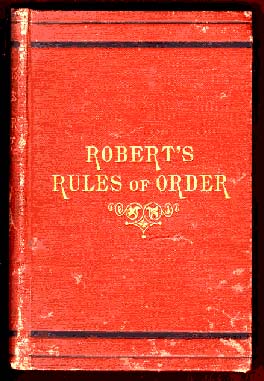Related Research Articles

Robert's Rules of Order, often simply referred to as Robert's Rules, is a manual of parliamentary procedure by U.S. Army officer Henry Martyn Robert. "The object of Rules of Order is to assist an assembly to accomplish the work for which it was designed [...] Where there is no law [...] there is the least of real liberty." The term Robert's Rules of Order is also used more generically to refer to any of the more recent editions, by various editors and authors, based on any of Robert's original editions, and the term is used more generically in the United States to refer to parliamentary procedure. It was written primarily to help guide voluntary associations in their operations of governance.

Parliamentary procedure is the accepted rules, ethics, and customs governing meetings of an assembly or organization. Its object is to allow orderly deliberation upon questions of interest to the organization and thus to arrive at the sense or the will of the majority of the assembly upon these questions. Self-governing organizations follow parliamentary procedure to debate and reach group decisions, usually by vote, with the least possible friction.
In parliamentary procedure, an adjournment ends a meeting. It could be done using a motion to adjourn. A time for another meeting could be set using the motion to fix the time to which to adjourn.

The American Institute of Parliamentarians (AIP) is a not-for-profit educational organization founded in 1958. The objectives of AIP are to promote the use and teaching of parliamentary procedure, as well as the training and certification of parliamentarians.
A special rule of order is parliamentary procedure term for a rule adopted by the organization that relate to procedure or to the duties of officers within meetings.
A parliamentary authority is a book of rules for conducting business in deliberative assemblies. Several different books have been used by legislative assemblies and by organizations' deliberative bodies.
In US parliamentary procedure, the previous question is generally used as a motion to end debate on a pending proposal and bring it to an immediate vote. The meaning of this specialized motion has nothing to do with any question previously considered by the assembly.
In parliamentary procedure, reconsideration of a motion may be done on a matter previously decided. The motion to "reconsider" is used for this purpose. This motion originated in the United States and is generally not used in parliaments. A special form of this motion is reconsider and enter on the minutes.
In parliamentary procedure, an objection to the consideration of a question is a motion that is adopted to prevent an original main motion from coming before the assembly. This motion is different from an objection to a unanimous consent request.
In parliamentary procedure, the motion to postpone indefinitely is a subsidiary motion used to kill a main motion without taking a direct vote on it. This motion does not actually "postpone" it.
In parliamentary procedure, a motion to appeal from the decision of the chair is used to challenge a ruling of the chair.
In United States parliamentary procedure, a suspension of the rules allows a deliberative assembly to set aside its normal rules to do something that it could not do otherwise. However, there are rules that cannot be suspended.
In parliamentary procedure in the United States, a motion to postpone to a certain time is used to delay action on a pending question until a different day, meeting, hour or until after a certain event. Then, when that time comes, the consideration of the question is picked up where it was left off when it was postponed.
Debate in parliamentary procedure refers to discussion on the merits of a pending question; that is, whether it should or should not be agreed to. It is also commonly referred to as "discussion".
In a deliberative assembly, disciplinary procedures are used to punish members for violating the rules of the assembly.

Alice Sturgis (1885–1974) was an author and parliamentarian, best known for writing the Sturgis Standard Code of Parliamentary Procedure. She was a practicing parliamentarian and consultant to national and international professional and business organizations. She taught at Stanford University and the University of California.
The history of parliamentary procedure refers to the origins and evolution of parliamentary law used by deliberative assemblies.
Parliamentary procedure is the body of rules, ethics, and customs governing meetings and other operations of clubs, organizations, legislative bodies, and other deliberative assemblies. General principles of parliamentary procedure include rule of the majority with respect for the minority.
In parliamentary procedure, the verb to table has the opposite meaning in the United States from that of the rest of the world: